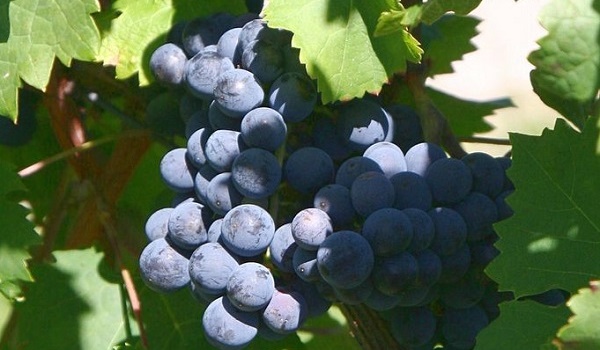Cabernet Franc Flavors
Red and Black Berries, and Pyrazine (Jalapeno) are typical Cabernet Franc flavors.
Hints of Perfume (Violets), Herbs, Spices, and Gravel or Graphite.
Strawberry |
Raspberry |
Black Cherry |
Blueberry |
Jalapeno |
Herbs |
Violets |
Pepper |
Common Uses of Cabernet Franc
As a Blending Grape
In Bordeaux, and in New World blends, Cabernet Franc adds:
- Aromatic complexity
- Herbaceous lift
- Softer tannins
- Earlier ripening (handy in cooler years)
As a Varietal Wine
Especially in:
- Loire Valley
- Argentina
- USA (New York, Washington)
In Rosé Wines
Especially in the Loire and parts of the U.S.
Cabernet Franc contributes with crisp acidity and herbaceous fruit.
About Cabernet Franc
Cabernet Franc is one of the parents of Cabernet Sauvignon (the other is Sauvignon Blanc). It is an older grape variety, and it likely originated in Spanish Basque Country as a cross from 2 local grapes: Morenoa and Hondarribi Beltza.
Even if Cabernet Franc is related to Cabernet Sauvignon it does not have the same qualities. Cabernet Franc is lighter, more fruity, less tannic, and it ripens earlier.
Cabernet Franc creates wines with great fruit aromas (raspberry, strawberry, cherry) and violets, as well as a spicy touch of bell pepper.
Cabernet Franc wines may lack some body, but they have a great aroma. It is often mixed with Merlot or big brother Cabernet Sauvignon, both of which give more fullness to the Cabernet Franc.
DNA
Cabernet Franc originated in Spanish Basque Country from 2 local grapes: Morenoa and Hondarribi Beltza.
It’s known as "Bouchet" in Saint-Émilion, "Bouchy" in the Pyrenées, "Breton" in the Loire Valley and Alcheria (Fox) in the Basque Country.
Terroir
Cabernet Franc is a worl-wide grape because it adapts to different terroirs, often the same terroirs as Cabernet Sauvignon.
Cabernet Franc loves sand, gravel, limestone, and clay.
The better performance in the world is in Saint-Émilion (Bordeaux), in the Loire Valley and in Italy (Tuscany and Friuli).
Cabernet Franc in France
In France, the most typical Cabernet Franc wines come from the Loire Valley where it is frequently made as a varietal wine.
In the Loire Valley (Chinon, Saumur, Bourgueil), Cabernet Franc is used to produce elegant, medium-bodied wines with red fruit, green pepper, and earthy notes.
In Bordeaux (especially Right Bank – Saint-Émilion, Fronsac, and Pomerol), Cabernet Franc is used in blends with Cabernet Sauvignon (Left Bank) and Merlot (Right Bank) to to add aromatic lift, finesse, and structure to the famous Bordeaux wines.
Cabernet Franc in Italy
In Italy, Cabernet Franc grows well in warmer microclimates and can be vinified both in solo or in blends.
Northern Italy grows Cabernet Franc with the same characteristics as in the French Loire Valley: A little green peppers and a juicy berry-like fruit with a dry and slightly firm aftertaste.
If the Northeast (Friuli) and in Tuscany (Bolgheri), Cabernet Franc is used in "Super Tuscan" blends with Merlot and Cabernet Sauvignon.
Cabernet Franc in Spain
In Spain, Cabernet Franc is mainly found in Catalonia.
In Catalonia it is used in 4 Denominaciones de Origen:
- Catalunya (DO)
- Conca de Barberà (DO)
- Penedès (DO)
- Terra Alta (DO)
Cabernet Franc in USA
In the USA, Cabernet Franc has shown a great potential in cooler areas.
In California (Napa and Paso Robles), Cabernet Franc is used in Bordeaux blends, richer and riper in style than the French versions. It is also made as a varietal wine, with black fruit and chocolate notes.
In New York (Finger Lakes), Cabernet Franc is produced in cooler climate styles more like in the Loire Valley: herbaceous, bright, and lower in alcohol.
In Washington State, it produces expressive and balanced varietal wines and is increasingly popular.
Cabernet Franc in Argentina
Cabernet Franc is producing top quality wines in Argentina (mendosa).
The grape has been said having the most potential in the country after Malbec.
In 2014, an Argentinian Cabernet Franc scored 97 points at Robert Parker.
High-altitude vineyards in produce elegant, perfumed wines with minerality and freshness.
Other Regions
In Australia and New Zealand, Cabernet Franc is mostly used in Bordeaux-style blends.
In Chile (Colchagua, Maipo), Cabernet Franc Shows potential with ripe, spicy styles.
Cabernet Franc is also planted in Hungary, Bulgaria, Slovenia, Croatia and Greece (known as Tsapournakos).
